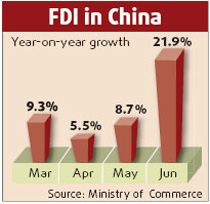The year 2007 was a good year for farmer Li Lin as his 20 tons of rice sold at a relatively high price amid the rise of prices of many other commodities in the country.
But Li, in Moshifang village in Zhuanghe County northeast China's Liaoning Province, said rising prices of farming labor and fertilizer ate up a great deal of his grain income.
"The labor cost for planting one mu of rice seedlings has risen from 50 yuan a few years ago to 80 yuan last year," said the 46-year-old farmer. The mu is a Chinese unit of area which equals 6.6 percent of a hectare.
Li said more subsidies were needed to improve farmers' conditions.
China's grain output exceeded 500 million tons in 2007. But the increasingly high agricultural costs also forced grain prices up.
The prices of major agricultural products had been been at low levels since the mid-1990s, whereas those of fertilizers and other means of production have risen substantially, said Wang Yiming, a National Development and Reform Commission expert.
Wang said the prices of carbamide, a major fertilizer Chinese farmers like to use, diesel and plastic sheeting had all risen by 26 percent to 64 percent over the past five years.
A type of compound fertilizer used for rice also soared from 110 yuan to 190 yuan per bag early this year in the area where Li lives.
Last year, the country's consumer price index (CPI) rose 4.8 percent last year, with the inflation indicator hitting an 11-year-high of 6.9 percent in November, well above the government target of three percent.
In particular, the average pork price nationwide rocketed 48.3 percent in 2007 from a year earlier, mainly due to supply shortages of pigs resulting from little profits in raising them and an outbreak of an infectious pig disease.
Since food has a weighting of 32.74 percent in the CPI, the stable supply of such commodities, farm produce in particular, will be a decisive factor behind China's efforts to beat inflationary pressures.
China has been subsidizing farmers in recent years in order to boost grain output to feed the country's 1.3 billion population. Li gets 15 yuan for each mu of his rented paddy field. Farmers who plant on their own farmland can get around 40 yuan of government subsidy per mu each year.
"If not for government subsidies and the exemption of agricultural taxes, farmers would make little money from planting crops given the high costs," said Yu Yongqing, head of Li's village.
The village official worried if farmers did not benefit more from planting crops, they may move to cities to find jobs for more money, posing a threat to the labor source for grain output.
On Wednesday, the country issued its first document this year, calling for greater efforts to increase grain output supply as part of the efforts to combat mounting inflationary pressures.
The document stressed that increased spending on agriculture this year should be a greater percentage than last year, the increase in fixed-asset investment in rural areas should exceed the year-earlier level and farm subsidies should be raised.
(Xinhua News Agency February 1, 2008)


